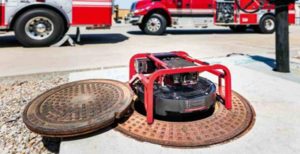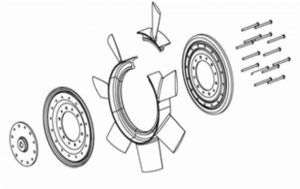 Selecting a fan for firefighting and rescue operations, much like a hand line nozzle, comes down to ensuring you have the right flow performance for the right mission. Flow performance includes flow volume, pressure, and stream pattern. The right combination of these performance factors will determine how successful ventilation tactics will be for a given mission.
Selecting a fan for firefighting and rescue operations, much like a hand line nozzle, comes down to ensuring you have the right flow performance for the right mission. Flow performance includes flow volume, pressure, and stream pattern. The right combination of these performance factors will determine how successful ventilation tactics will be for a given mission.
When a new fan is being conceptualized, there are several factors of airflow that will ultimately effect the flow performance to be delivered; the impeller, the motor, and the stream pattern. This concept of Flow Path Control is at the very core of our operations at Euramco Group, and we've made it our priority to engineer the best fans for the mission, whether it be Naval shipboard damage control, offshore drilling platform operations, hazardous area confined space work, or frontline firefighters and rescuers.
Impeller
Just like a fire pump, the impeller (Fig. 1) of a fan is engineered to deliver a certain flow and pressure at a given input power (kW) and rpm. And, just like a fire pump, the intended output performance of the impeller can only be achieved if the required input power and rpm is delivered. Once a mission profile is known, a properly designed impeller and an appropriate powered motor can be built.
In general, greater flow is necessary for larger structures or more aggressive, or offensive, ventilation tactics. This can be achieved on a fan with either larger diameter or RPM. Greater head, or pressure, is necessary to overcome friction loss through a hose, duct, or complex flow path (i.e. hallway, doors, etc.). As with confined space ventilators, the impeller airfoil shape is noticeably different than most PPV fan impellers because of its design for a specific mission; pressure being more important than flow.
Stream pattern
Shaped stream pattern can be beneficial for different missions as well. Straightened airflow can help to create more head, but also allows for further throw distance (i.e. fan setback from structure entrance).
The PPV fans you grew up with were limited in their use. The “cone effect” was largely a marketing justification for the design limitations of the fans being made at the time. As an impeller turns, the air moving through it begins to spin, resulting in an emphasized centrifugal force as the air moves beyond the fan shroud – forcing the stream pattern wider and wider, just like a fog pattern on a hand line nozzle – losing airflow velocity very quickly and only delivering effective air movement for up to 1.5m or less.
The recent introduction of “stream shaping” (Fig. 2) to firefighting fans, a feature that has been present in industrial fan types for many years, has really expanded the operational flexibility of PPV fans on the fire ground. Positioning flexibility is the most often cited benefit, with the ability to position the fan far beyond the 1.5m limit of traditional stream pattern (i.e. “Cone of Air,”or fog/spray pattern) fans and still deliver appropriate volumes of airflow to, and more importantly through, the structure.
Beyond flexibility in positioning, and back at the basics of fan engineering, is airflow velocity. Shaping the stream into a straighter, tighter pattern counteracts the centrifugal force of the spinning impeller to straighten the airflow as it leaves the shroud. This increases the velocity, or speed, of the airflow.
In practice, this accelerated flow – like a fire pump – can overcome the friction loss of a complex structure as the flow path moves into the entry point and towards the established exhaust.
In short, whereas the old PPV fans were focusing on getting the air to the entry door, new PPV – or those with more straightened, accelerated flow performance – are built to better deliver air through the structure and out the back door. This new development brings air velocity (m/s) to the top of the list of metrics when comparing fans for structural PPV rather than simple airflow volume (m3/hr), which does not consider how different size doorways and complex hallway systems can dramatically restrict, if not completely stop, lower velocity air movement through a structure.
Motor
Until recently, impeller design has been limited to the performance limitations of available motors on the market. Where gasoline-powered PPV fans are concerned, Honda's 4.8hp and 5.5hp small engines determine the ultimate airflow output of the fan, and have for the past two decades. Any variance in basic performance from any one brand of PPV fan to another is relatively minor if the exact same motor is used.
Electric motors are much the same story, but without the hallowed name of a Japanese engine maker. Off-the-shelf AC motors are cheap and simple, not requiring much electrical expertise to integrate into a fan – connect positive, negative, ground, and you're – pretty much – good to go. Recent developments, however, in electronically-commutated brushless motors, multi-layer printed circuit boards (PCBs), and firmware encoding have made the motor an advanced piece of equipment that very few “off-the-shelf” motor manufacturers produce in the size range necessary to power PPV fans in the fire service. The new BLDC motor range by Euramco Group is the first specially developed high-performance brushless motor for firefighting ventilation. Controlling a BLDC requires considerably more circuitry than its less-efficient, noisier, short-lived, heavier predecessors, so a new generation of RAMFAN's IntelliSense™ motor controller – the E2 – was designed.
New technologies
In the past several years, there has been a confluence of new technologies that have found their way into the firefighting service and begun a major evolution in equipment design, leaving many manufacturers scrambling.
The new IntelliSense E2 controller is fully loaded. It uses motor position information from embedded sensors to electronically switch the stator windings in the correct sequence to maintain rotation of the magnet assembly. The IntelliSense E2 combines this firmware-defined motor controller with two integrated battery management systems (BMS) and integrated battery chargers – all on a single printed circuit board (PCB) in a control box that is smaller than most laptop computers.
Battery packs are the other real engineering feat facing manufacturers of fire equipment. Due to the necessity of extreme durability, waterproofing, and high draw applications found in the fire service, fire equipment manufacturers are finding themselves having to develop their own systems to answer the new, evolving demands of their customers. Few have succeeded in designing (or sourcing) acceptable solutions.
Battery technology, probably first seen in radios, lighting, and TICs then moving to take a sizeable chunk out of the rescue tool market, is now taking over the fan world. Interestingly, however, few have recognized the hard-won lessons of their manufacturing brethren in other categories. The first PPV fans to integrate battery power did so with fixed batteries, meaning they can't be swapped out when depleted. This means it needs to be removed from service and plugged in for hours (typically 6-10 hours) at a time until it is fully recharged before being put back into service – unacceptable to any fire department who takes time to think it through. Swappable packs can be replaced in 30 seconds once depleted, making sure the vehicle is ready to roll – fully equipped – as soon as it returns to the station.
Hot-swapping battery packs (Fig 3.) is one feature that Euramco engineers required in the design of the RAMFAN® 40V 6.0 Ah Li-Ion Battery Pack. Hot swapping battery packs requires more than one pack per fan, one pack can be swapped at a time, so the flow path is never interrupted or broken – a critical consideration to departments who train often on ventilation tactics.
Finally, battery protection. This is the most often overlooked and arguably most important factor in any battery-powered equipment. Batteries are very sensitive to several factors: overcharge, undercharge, extreme temperatures, and current leakage. A battery management system (BMS) that protects the battery cells from each of these is critical to ensuring the battery does not suffer damage resulting in reduced runtime and reduced useful life (charge cycles). Without proper protection from these risks, fire departments should strongly be discouraged from investing in battery-powered equipment, whether a fan, rescue tool, and anything to avoid the risk of a shortened life equipment with very high total lifecycle costs (i.e. maintenance, service, replacement).
hatever your venting mission (Fig.4), from confined space rescue, structural fire suppression, overhaul, or rehab, choosing a fan that is engineered to deliver the right flow performance for your mission is critical to mission success. Understanding what goes into the design of a fan, the factors of airflow, will help you to make an educated decision.

















































